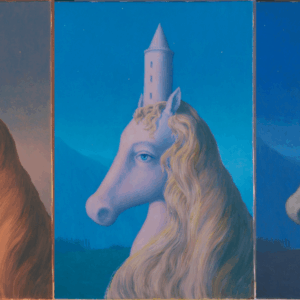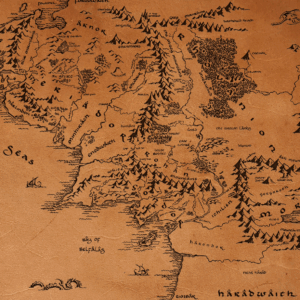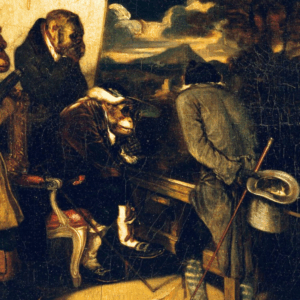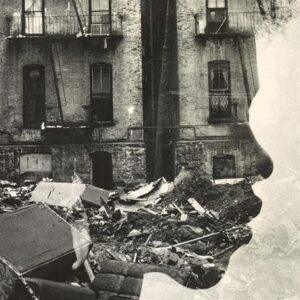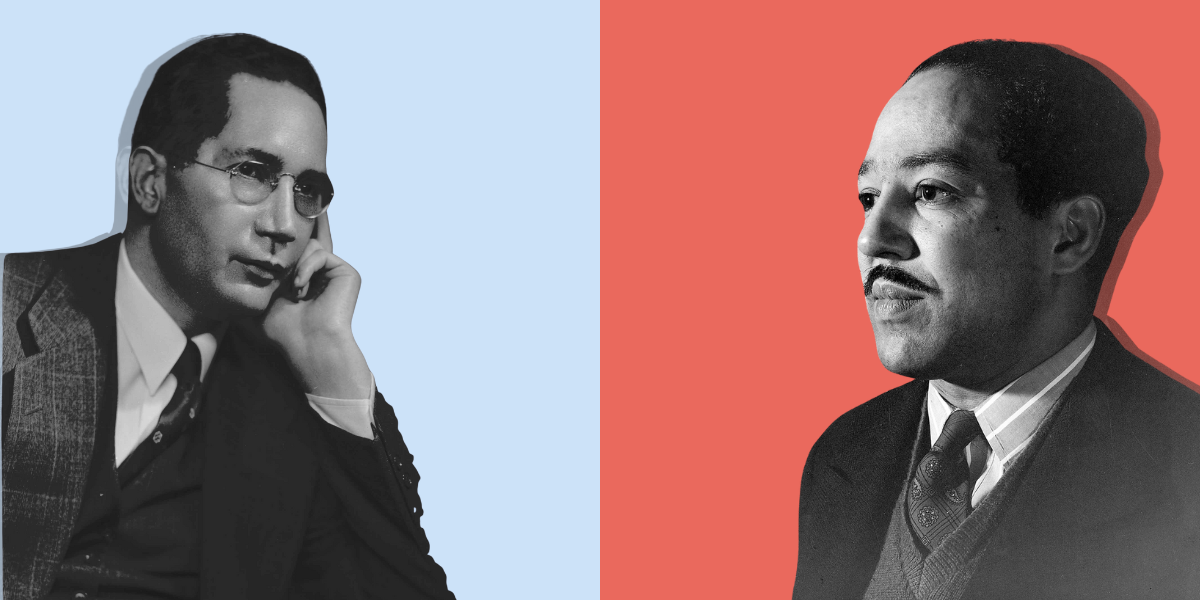
How Black Labor Unions Impacted the Creation of the Stanzaic Blues Poem
Kristin Grogan on the Poetry of Langston Hughes and Sterling Brown
Langston Hughes’s 1927 sophomore collection, Fine Clothes to the Jew, a follow-up to the previous year’s The Weary Blues, describes the lives of service workers, alcoholics, gamblers, sex workers, and prize fighters. The book was largely praised by the white press but reviewed poorly in the Black press, where Hughes was described as a “sewer dweller,” a writer of poems that “reek of the gutter,” and the “poet ‘low-rate’ of Harlem” (a pun on “laureate”) who wrote an “unsanitary, insipid and repulsing . . . commentary on the psychology of the ‘new Negro.’”
Hughes would later claim that the poems originated in his own experience of service work, writing that they were written “while I was dragging bags of wet wash laundry around or toting trays of dirty-dishes to the dumb-waiter of the Wardman Park Hotel in Washington.” An elevator attendant in such a hotel appears in “Elevator Boy” from Fine Clothes:
I got a job now
Runnin’ an elevator
In the Dennison Hotel in Jersey.
Job ain’t no good though.
No money around.
Jobs are just chances
Like everything else.
In Hughes’s 1930 Bildungsroman Not Without Laughter, Sandy, the protagonist, finds work as an elevator attendant after moving from Kansas to Chicago. Hughes details this work in the book’s penultimate chapter, “Elevator”:
At the hotel Sandy’s hours on duty were long, and his legs and back ached with weariness from standing straight in one spot all the time, opening and closing the bronze door of the elevator. He had been assigned the last car in a row of six, each manned by a colored youth standing inside his metal box in a red uniform, operating the lever that sent the car up from the basement grill to the roof-garden restaurant on the fifteenth floor and then back down again all day. Repeating up-down—up-down—up-down interminably, carrying white guests.
After two months, “there were times when Sandy felt as though he could stand it no longer.” He works with older men, like his coworker Mr. Harris, who have been on this job for decades. The repetition of the job, “the same doors opening at the same unchanging levels hundreds of times each innumerable, monotonous day,” looms before Sandy. Unlike Mr. Harris, however, Sandy manages to leave, and by the end of the novel he is planning to return to high school.
There’s a heavy resignation to this poem, in which jobs are “just chances / Like everything else.”
The poem promises no such thing. The elevator’s rising and falling traps its attendant in a Sisyphean labor that raises the attendant and lands him inexorably back on the ground in sharp monosyllables: “up an’ down, / Up an’ down.”
There’s a heavy resignation to this poem, in which jobs are “just chances / Like everything else.” The elevator’s movement makes a game of chance out of the myth of occupational and social mobility. That there will be no end to this or to similar labors is underscored by the speaker’s imagining of the next job, consisting of “somebody else’s shoes / To shine, / Or greasy pots in a dirty kitchen.”
“Somebody else’s shoes” seems to offer the promise of change by holding on to the idea that the elevator worker might step into somebody else’s life. But the line breaks; those shoes will be made “to shine,” and labor will continue. The poem’s final line reformulates its first line, “I got a job now”:
I been runnin’ this
Elevator too long.
Guess I’ll quit now.
Able to move upward only as far as the elevator rises, then quickly plunged to earth again, the elevator worker chooses to end his trials. John Marsh reads this line optimistically, writing that the “casualness of the sentiment reveals how little is at stake in the decision [to quit]—yet how important the always available strategy of quitting was to make service work manageable.”
I agree that its sentiment is casual, but it is casual only because the gesture is almost meaningless. The boy can quit abruptly because there will be more interchangeable jobs—more elevators, more shoes, more greasy pots. The decision to quit amounts to no ending at all.
Fine Clothes paints a picture of the racist working conditions of Jim Crow America. In service jobs, Black workers labored as porters, chauffeurs, and servers; in manufacturing plants, white supremacist pseudoscience was harnessed to justify forcing Black workers to perform the most difficult and dangerous work.
By 1920, the Black industrial workforce had increased by more than 150 percent, whereas the percentage of Black farmers had decreased by 30 percent. Yet while the numbers of Black workers in industry swelled, the racism of organized white labor meant that Black workers were excluded from unions and largely absent from the strikes that defined the 1910s.
Black union representation increased in the 1920s, in part because of Soviet recognition of the oppression of Black laborers and the Soviet conviction that untapped revolutionary potential was to be found outside Western Europe. A homegrown Black labor movement gathered strength from the mid-1920s onward.
In October 1925, the American Negro Labor Congress took place in Chicago with five hundred attendees who aimed to build a militant workers’ organization. “Unquestionably,” wrote Robert Minor in Workers Monthly, “this convention resulted in forming a strong nucleus for a mass movement, and a nucleus which already has the beginnings of mass connections.”
Some of the Black labor movement’s early successes came from the efforts of the fifteen thousand workers employed as porters for the Pullman Company who organized in the summer of 1925 to form the Brotherhood of Sleeping Car Porters (BSCP).
White supremacy is constructed and maintained by Black service work and by the extraction of a social performance of deference.
After three years as an independent union, in 1928 they shocked white delegates at the American Federation of Labor convention by applying for an international charter. Porters worked an average of four hundred hours a month for poor wages (the starting salary for regular workers was sixty-seven dollars a month, with the cost of uniform, shoe polish, meals, and so on deducted from their wages); they carried luggage, shone shoes, cut hair, served drinks, and adhered to a strict code of etiquette.
This kind of work kept the link between Black working men, servitude, and enslaved labor alive. In their unionization campaigns, the BSCP “drew upon the memories of slavery and emancipation to connect the union’s challenge to the Pullman Company to the larger quest for first-class citizenship in the broader political arena.” Hughes describes a porter’s labor in a poem from Fine Clothes:
I must say
Yes, sir,
To you all the time.
Yes, sir!
Yes, sir!
All my days
Climbing up a great big mountain
Of yes, sirs!
Rich old white man
Owns the world.
Gimme yo’ shoes
To shine.
Yes, sir!
Hughes realizes this endless labor, also Sisyphean, vertically as “a great big mountain / Of yes, sirs!” This poem’s motivating energy is the repetition of two words—“Yes, sir!”—which register the affective labor of the porter, a labor that demands the workers’ obedience and willingness to produce comfort and domination in the person they serve.
The “great big mountain” of the porter’s work echoes the title of Hughes’s famous essay published in The Nation the previous year, “The Negro Artist and the Racial Mountain,” in which Hughes traced “this urge within the race towards whiteness, the desire to pour racial individuality into the mold of American standardization, and to be as little Negro and as much American as possible.”
White supremacy is constructed and maintained by Black service work and by the extraction of a social performance of deference. By interjecting the porter’s thoughts with the discursively imposed language of his labor (“Yes, sir!”), “Porter” shows how whiteness demands a standardized Black affective labor that enforces racial hierarchies.
The major formal innovation of Fine Clothes to the Jew is the stanzaic blues poem. Along with Sterling Brown, Hughes is credited with transforming the rich musical tradition of the blues into a standardized poetic form. In his prefatory “Note on Blues,” Hughes defines the form in terms of its “strict poetic pattern: one long line repeated and a third line to rhyme with the first two.”
Each individual blues poem is part of a larger body of poems that work through similar themes and experiences, told by similar characters.
To this he adds a reminder that the blues define a distinctive mood, which is “always despondency, but when they are sung people laugh.” The blues poem’s effect is largely in its handling of repetition followed by modification or change. Hughes suggested that the third line “rhymes” with the repeated first two lines—just as the sound pattern of rhyming shapes meaning, that third line can reinforce, challenge, or modify the preceding two lines.
The standard form of the blues poem also means that the poem can be repeated; each individual blues poem is part of a larger body of poems that work through similar themes and experiences, told by similar characters.
Take, for example, Sterling Brown’s trio of poems, “New St. Louis Blues.” The first poem, “Market Street Woman,” shows us the life of a down-on-her-luck sex worker; the next, “Tornado Blues” describes the “dirty work” of a tornado that pulverizes a neighborhood; and “Low Down” gives us a man asking for tobacco, “bummin’ cut plug from passers by.” Aimless, wageless, and unemployed, the speaker of “Low Down” meditates on his lucklessness in a variation on the idea of luck that we saw in Hughes’s “Elevator Boy.”
Here, the “dice are loaded,” and the “deck’s all marked to hell,” as the speaker’s path in the afterlife is clear. Where “Elevator Boy” ends with a sudden refusal of labor, Brown’s poem underscores the entrapment of the man asking to borrow tobacco, mapping this onto a larger system of inequality and suffering.
“New St. Louis Blues” shows us not an individual instance of suffering but a shared experience of Black immobility and unemployment. The repetition with which the blues does its work—both within the individual stanza and as a repeated, repeatable form—indexes Black unfreedom, even as it refuses the myth of social mobility and racial uplift through hard work.
Brent Hayes Edwards reminds us that the blues poems that Brown and Hughes were writing did not constitute “a recognized subgenre, but instead an area of literary experimentation in open concert with a brand of commercial music viewed as licentious or degenerate.”
The poems were also deemed degenerate for the socially and economically marginalized lives they represented. Their speakers are unemployed or precariously employed and geographically displaced, subject either to forced immobility or migration. The blues poem is frequently poised at the moment of departure, the train pulling away from the station, a life left behind. Brown’s poem “Riverbank Blues” limns the contradictions of enforced mobility, with “muddy streams” keeping the speaker “fixed for good” and the river threatening to leave the man “in some ornery riverbank town.”
In their intertwined immobility and dispossession, the speakers of Hughes’s and Brown’s blues poems exemplify the “bare life” that Michael Denning, reformulating Marx’s account of the surplus population of labor, describes as those who are “disposable in the eyes of state and market.”
Denning invites us to understand that “ ‘proletarian’ is not a synonym for ‘wage laborer,’ . . . but for dispossession, expropriation, and radical dependence on the market. You don’t need a job to be a proletarian: wageless life, not wage labor, is the starting point in understanding the free market.” We can see this dispossession and dependence at play in the first stanza of Hughes’s poem “Bound No’th Blues”:
Goin’ down the road, Lawd,
Goin’ down the road.
Down the road, Lawd,
Way, way down the road.
Got to find somebody
To help me carry this load.
Its space is at once endless and constricting. The road expands, but it offers nothing beyond this expansion, nothing beyond the point of “way, way down.”
The poem’s speaker is unnamed, one of the millions of Black Southerners who left the South for the North seeking an escape from Jim Crow, white supremacist terror, and coercive labor practices. Margaret Ronda calls on Denning’s concept of wageless life in her reading of Paul Laurence Dunbar’s 1896 Lyrics of Lowly Life, writing that Dunbar’s agrarian laborers—at once bound to their work and disposable—elaborate “a plot that runs counter to capitalist economic language of value, measure, exchange, and progress; to the ideology of the work ethic and virtuous wealth; and to racial uplift narratives centered on productive labor.”
Like Dunbar’s speakers, Hughes’s dispossessed have no way out, and the poem implicitly refutes optimism regarding the Great Migration and racial progress. Whereas “Elevator Boy” and “Porter” are oriented vertically, here the orientation is primarily flat and horizontal, toward the stretch of “way, way down the road.” Its space is at once endless and constricting. The road expands, but it offers nothing beyond this expansion, nothing beyond the point of “way, way down.” Itinerancy, mobility, and dispossession are not temporary features but continually reinforced; they are not a line to move across but a space one is forced to sit within.
The speaker never makes it North, and the poem refuses even to rehearse the familiar narrative of disappointment in Northern racism. “Road’s in front o’ me, / Nothin’ to do but walk. / Road’s in front o’ me, / Walk . . . an’ walk . . . an’ walk.” The poem leaves us suspended in the endless walking as movement becomes another constricted condition.
I have indicated that the specific energies of the blues stanza are formed by the repetition of its A-A’-B structure, with a line repeated—Hughes often breaks his into two lines—followed by a third line that resolves, reiterates, or offers a counterpoint to the first two. “Bound No’th Blues” does enormous work with this formal structure of repetition and reformulation. Here is its final stanza:
Road, road, road, O!
Road, road . . . road . . . road, road!
Road, road, road, O!
On the no’thern road.
These Mississippi towns ain’t
Fit fer a hoppin’ toad.
“Road” is stated twelve times in four lines. In the first three lines, it is the only word, the only linguistic feature besides two ellipses and two exclamatory Os, which are vocal but nonverbal. Its repetition is both insistent and emptying; there is (literally) nothing but road in those lines. Here, road comes to mean repetition itself. It signifies persistence, predictability, and inescapability, as well as an ironic refusal of progress. “Road” repeated enough becomes the condition of being on the road.
Once again, no alternative is presented, for the North exists only as the road’s direction, and Southern towns cannot be tolerated; they “ain’t / Fit fer a hoppin’ toad.” The rhyme lands heavily on the “hoppin’ toad,” which brings out the wry, melancholy humor of the blues.
“Hoppin’ ” registers the speaker’s itinerancy (it was contemporary slang for hopping onto a moving train, or getting a ride without paying), but it also gives the speaker a kind of elegance: “hoppin’ ” suggests a dance or shuffle, as well as a kind of pragmatic light-footedness, which brings us back to the distinctive rhythm of the blues poem. Even as the poem holds the threat of racist dehumanization over the speaker’s head, it refuses that in favor of humor and grace.
In a belittling review of Fine Clothes to the Jew printed in New Masses in 1927, Kenneth Fearing wrote that Hughes’s poetry made use of “dialect and jazz rhythm . . . with as much success as anyone has achieved using those limiting devices.”
“The trouble with these successes,” Fearing declared, “is that they are small, the poems are little better than poignant playthings.” Fearing’s description of Hughes’s poems as mere “playthings” is the mirror image of the complaint against Hughes’s insufficient lyricism that would be levied by Van Vechten six years later: that the poems are too functional, too far from poignant playthings.
Fearing missed, of course, the way that Hughes’s blues poems develop a political aesthetic. Reading Brown’s and Bessie Smith’s blues in relation to the 1927 Mississippi floods, Sonya Posmentier writes that the structure of environmental catastrophe “itself provides the aesthetic alternative to teleological narrative” because catastrophe’s structure is “repetitive, migratory, circulatory, transformative, dispersive, and connecting.”
In Brown and Hughes, the devices of the blues poem index the repetitive and dispersive conditions of wageless Black life in the 1920s. But blues irony evokes this stuckness and forced repetition; it doesn’t provide a transformative vision. Or, to put it in Anthony Reed’s terms, “the blues underscores what needs transformation.”
__________________________________
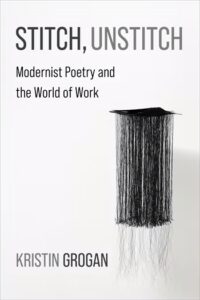
Excerpted from Stitch, Unstitch: Modernist Poetry and the World of Work by Kristin Grogan. Copyright (c) 2025 Columbia University Press. Used by arrangement with the Publisher. All rights reserved.
Kristin Grogan
Kristin Grogan is an Assistant Professor in English at Rutgers University. Her research and teaching focus on modern and contemporary poetry and poetics, labor history and theory, and gender and sexuality. She is finishing her first book, an account of the dynamic relationship between poetry and labor of various kinds—artisanal, mechanical, clerical, and reproductive work—with chapters on Langston Hughes, Ezra Pound, Gertrude Stein, and Lorine Niedecker. She is beginning a new project on feminist and queer poetics and anarchism in the USA, from Emma Goldman to now. Her writing has appeared in American Literature, Critical Quarterly, Social Text Online, and Post45; most recently, she edited, with David B. Hobbs, a special issue of Post45 Contemporaries on Bernadette Mayer.









